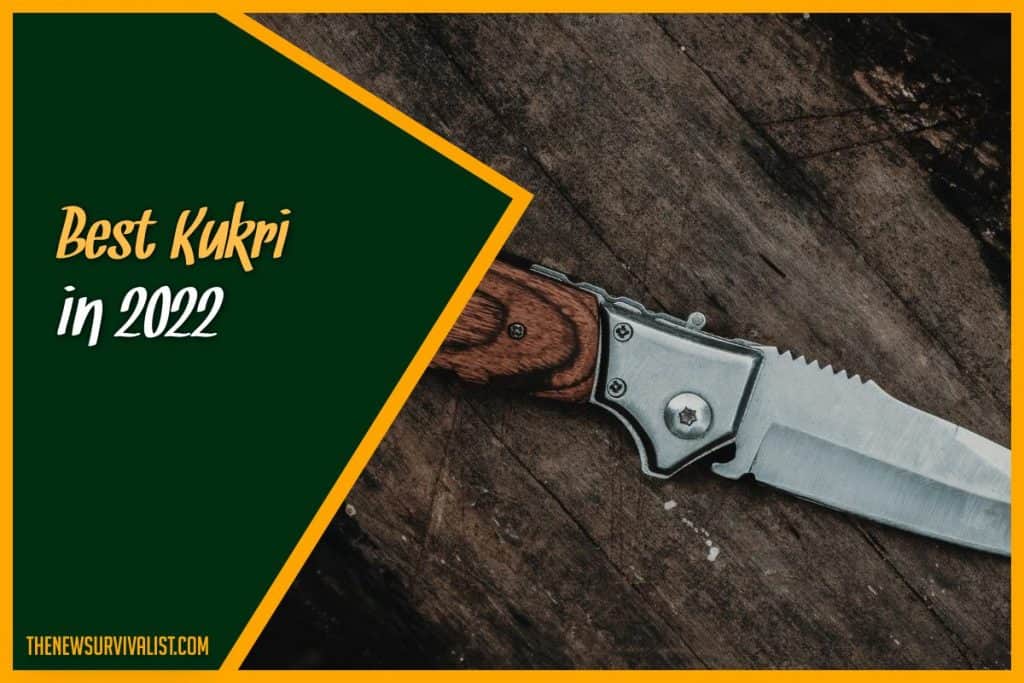When there’s no room for more than one knife/machete in the backpack, a lot of bush crafters and survivalists these days would veer towards the best kukri.
This highly utilitarian Gurkha knife from the Himalayas has for long been an American favorite. (Pre-WWI)
More recently, it has been a staple on television, and has attained a cult status of sorts among campers who are fascinated with the rich history that it boasts of.
A closer look at it reveals that all the adulation that the best kukri receives is not unjustified either.
It’s a hunting knife, a combat knife and has tremendous chopping power if you can twist the wrist when you swing. You can pierce, hack, chop, peel as well as perform a few finer tasks without breaking a sweat.
However, shopping for these knives can be a challenge unlike any other for there are kukris in hundreds of sizes, shapes and configurations.
That’s where we step in.
Here are our recommendations for the best kukris in 2022.
#1 – KA-BAR 2-1249-9 Kukri
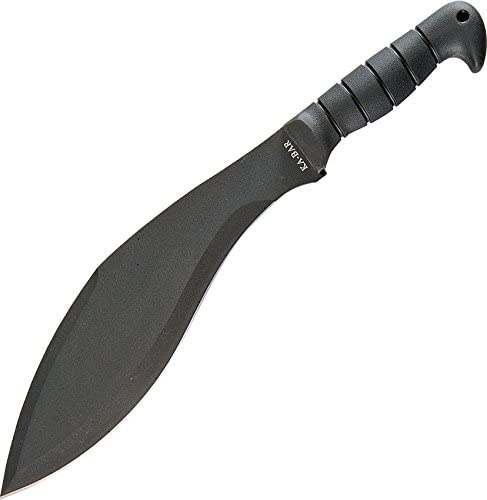
This brute of a kukri from KA-BAR features a 1085 Carbon steel blade with a plain edge.
Crafted in Taiwan, it is advertised as a machete with a Kukri-styled blade on it.
So, it’s designed to hack through undergrowth and clear shrubs around camp. But the curved belly and the aggressive tip make it perfect for other tasks like chopping, filed dressing and peeling barks.
The blade is 0.165” thick and it is full-tang constructed. So, you can baton the spine without damaging the edge.
Talking about the edge, the 1085 steel gets shaving-sharp with very little effort and holds the edge like nobody’s business. It can take an absolute pounding in the field and still retain the sharpness.
The Kukri features a thermoplastic elastomer handle that fits snugly in your palms. It has a non-slip grip that ensures that sweat, water or blood (dressing) do not limit the functionality.
The blade is 11 ½” whereas it measures 17” overall. Not exactly a pocket-sized knife. But like we mentioned, it’s part machete and that’s a compact knife by machete standards.
Comes with a lanyard hole and a cordura-leather sheath to round up, what’s a great package.
Pros
- Heavy-duty Kukri from KA-BAR
- Machete with a Kukri-styled blade
- 1085 Carbon steel
- 185” thick blade
- Full Tang construction
- Perfect for cleaing through undergrowth as well as for finer tasks
- 11 ½” blade and 17” overall
- Comes with a Cardura/leather sheath
Cons
- None that we could find yet
#2 – EGKH Genuine Gurkha Aeof Kukri
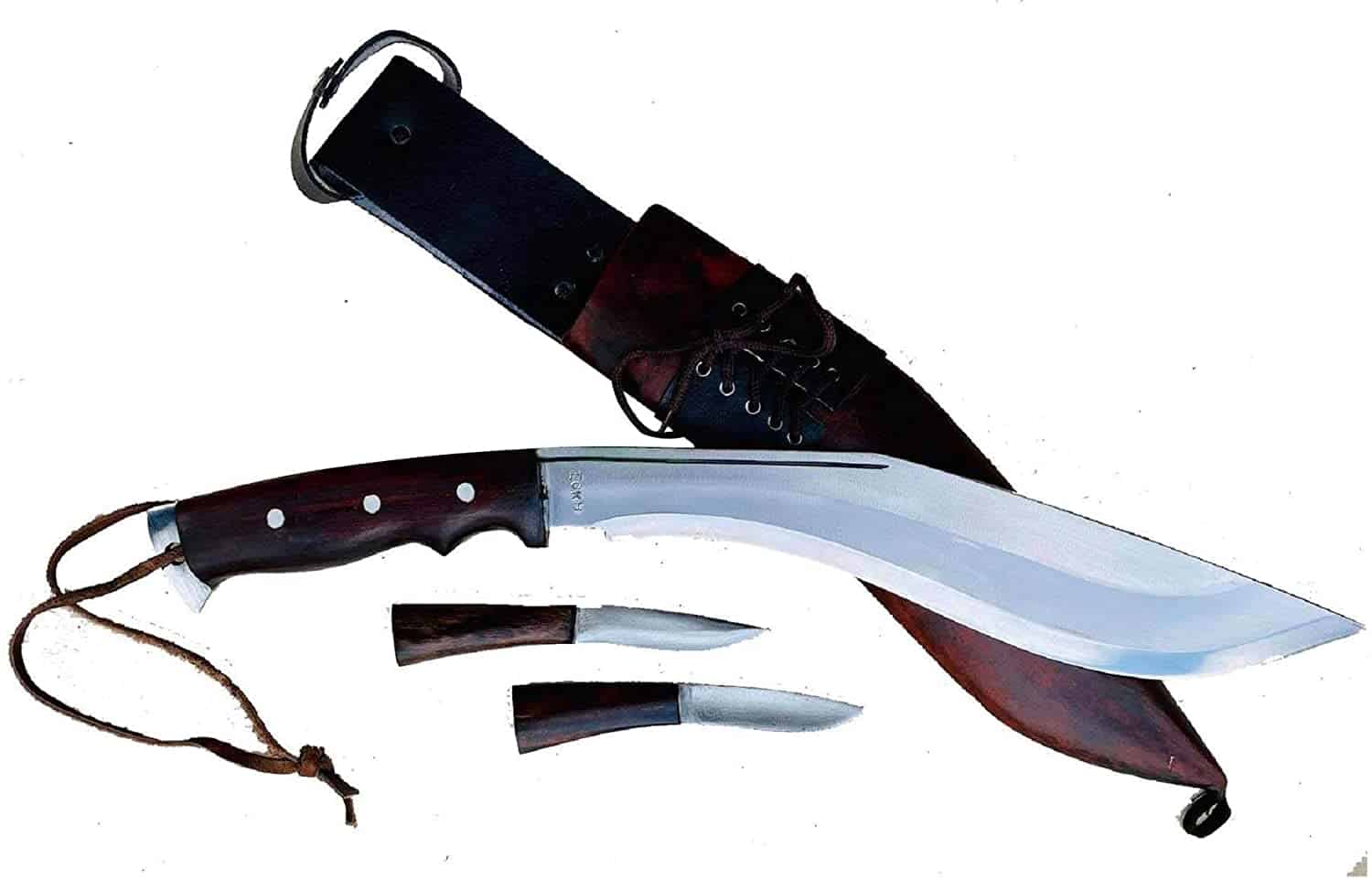
This is an authentic Nepalese Kukri handcrafted by a skilled ‘Bishwakarma’ (Kukri maker) in the tiny Himalayan kingdom of Nepal.
It features a 11″ Carbon steel blade (salvaged from a Jeep leaf spring) that’s about 10mm thick at the spine and comes with an extremely sharp, flat, Angkhola-Styled edge that’s tailor-made for chopping and splitting.
As expected for a knife this size, it weighs 1.76 lbs. and isn’t exactly made with portability in mind.
But it can make short work of most tasks around camp. Also, there’s a flat edge on the spine that can be used for batoning.
The Kukri comes with a 5” ergonomic, thick, rosewood handle with finger grooves that provide a comfortable grip.
It is full tang constructed and extremely durable.
Like all Nepalese handmade kukris, it comes with a semi-polished blade that will develop a lovely patina with use. Don’t fret if it rusts. You can remove the rust easily. That’s considered as part of the aging process for Kukris.
The manufacturers also throw in two smaller knives as freebies. The ‘Karda’ is perfect for finer tasks like skinning an animal whereas the ‘Chakmak’, which has a blunt edge is used to sharpen the Kukri.
It comes with a buffalo hide sheath that isn’t the best. But that’s just a tiny quibble. Everything else about the Kukri is just perfect.
Pros
- Handcrafted by skilled, traditional Kukri makers in Nepal
- 11” Carbon steel, Angkhola-styled blade
- Ergonomic, rosewood handle
- Full-tang constructed
- Comes with two smaller knives. One for finer tasks and the other for sharpening the Kukri
- Perfect for chopping, splitting
Cons
- Weighs 1.76 lbs.
- The buffalo-hide sheath is not the best and will probably need to be replaced in a while
#3 – Cold Steel 97KMPS Machete, Kurki
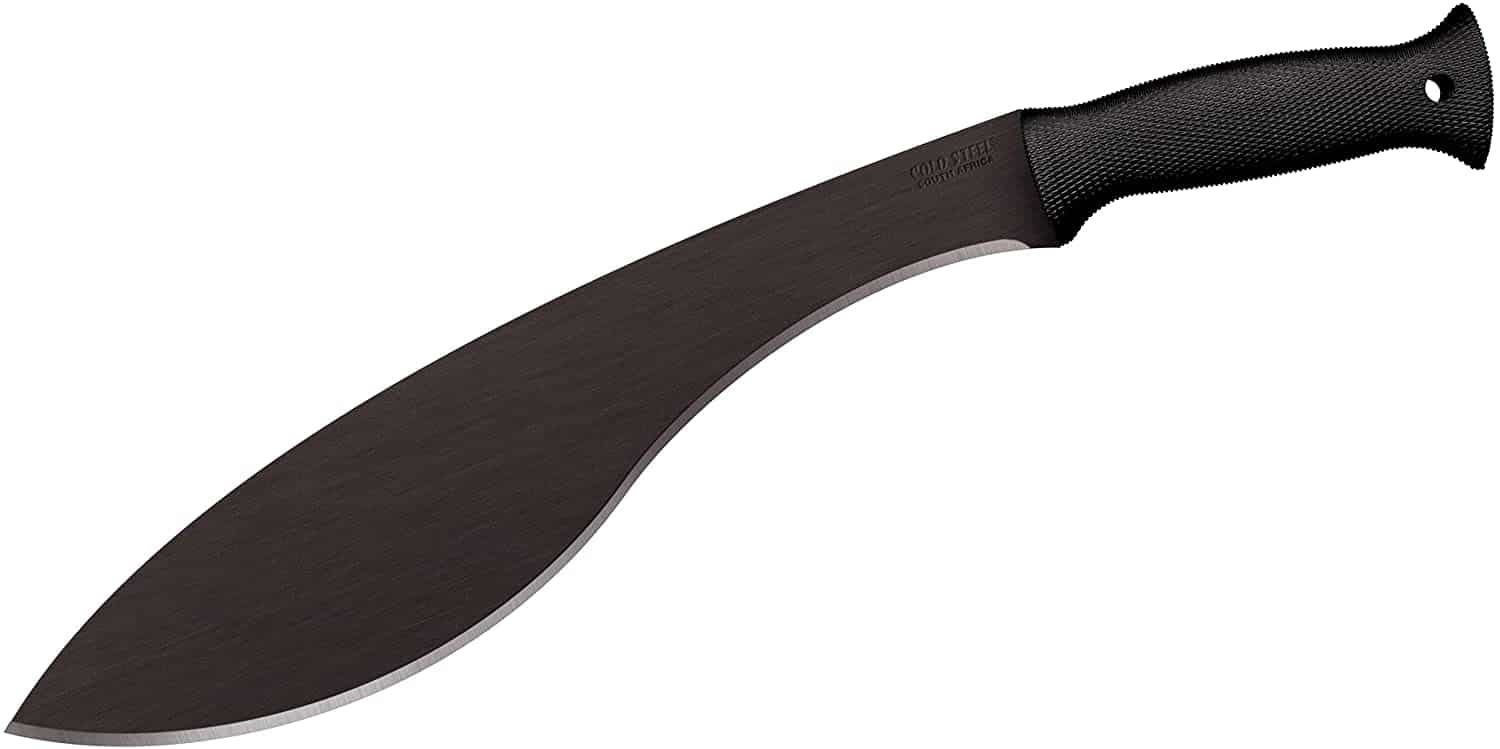
This is a fine Machete-Kukri hybrid from Cold Steel that comes with a 13” long blade that’s 2.8mm thick.
It is thicker than most machetes at this price point. But the 1055 carbon steel construction provides it with enough flex to withstand batoning without snapping on you, even if you drive it into twisted, knotty wood.
The edge comes razor sharp and it has the conventional, curved Kukri belly with perfect balance and heft.
You can use this for bushwhacking as well as for more precise tasks around camp.
It has a very tactical, black, baked-on, anti-rust matte finish that deters rust, but also prevents the knife from acquiring the natural patina that comes with exposure to the elements.
If you like it aged with the natural patina, it’ll take some elbow grease to strip down the coating. (Not recommended)
The construction is full tang and it comes with a 5” Polypropylene handle with a non-slip finish.
Instead of the conventional ‘Cho’ or Kukri notch, it features a solid steel, safety guard that will keep you covered in case of an accidental slip.
Cold Steel also throws in a Cordex sheath which is only functional at best. The sooner you swap it with a custom Kydex rig, the better.
Pros
- Budget-priced machete, kukri hybrid
- 12”, 1055 carbon steel blade
- 8 mm thick with enough flex for chopping wood
- Razor sharp edge
- Tactical black, anti-rust finish
- 5” polypropylene handle
- Sold steel safety guard
Cons
- Poor quality cordex sheath
#4 – EGKH. Genuine Gurkha Hand Forged Kukri
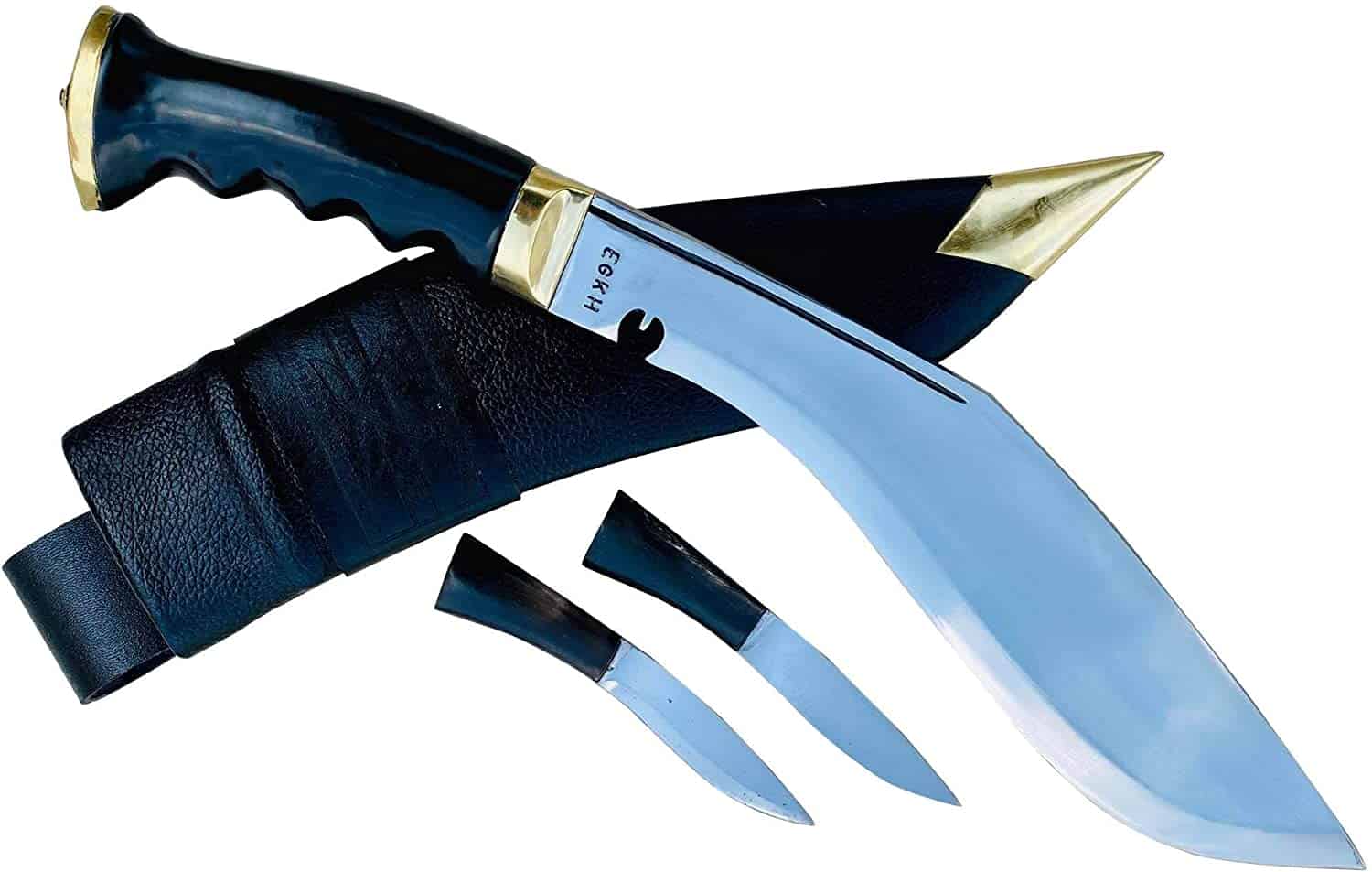
We just cannot stop drooling over authentic, handmade Kukris like this 11” one from EGKH.
It is a quintessential Gurkha Kukri made in Nepal and imported to the rest of the world.
It features a durable, carbon steel blade with a razor sharp edge and a 9mm thick spine that can easily withstand batoning without forming dings in the blade.
Hacking undergrowth, building shelters, digging tent poles, deboning large game, this versatile knife can do it all.
And for the tasks that need a svelte blade, EGKH throws in the ‘Karda’ for free.
The knife also features the famed ‘Cho’ or the notch just near the bolster. So any guts and blood that you spill are not going to smear your hands.
What separates this from a mass-produced knife is the balance and the heft, which is just perfect. The weight is centered near the shoulder and the recurve which make it a great machete alternative.
There is no vibration when you make contact with the blade on a thick branch.
Like most carbon steel blades, it holds its edge for weeks if not more. But it is prone to rusting and the satin finish will be replaced by a natural patina.
That shouldn’t be a problem though unless you intend to prop this on the wall as a conversation piece.
Unlike true blood Nepalese Kukris which have a buffalo horn handle, this one comes with a rosewood handle with finger grooves and a lanyard hole.
It’s a snug fit and doesn’t slip even when you are swinging it wildly. Will work just fine for the zombie apocalypse.
Pros
- Authentic, hand forged Nepalese Kukri
- Steel blade with am unpolished, satin finish
- 10mm thick spine, 5.5inch recurved belly
- Perfect balance and weight
- Can be used as a machete as well as a camping knife
- Rosewood handle with finger grooves
- Features the Cho near the bolster
Cons
- Big and heavy. May not be suited for campers looking for a lightweight option
#5 – SOG SOGfari Kukri Machete
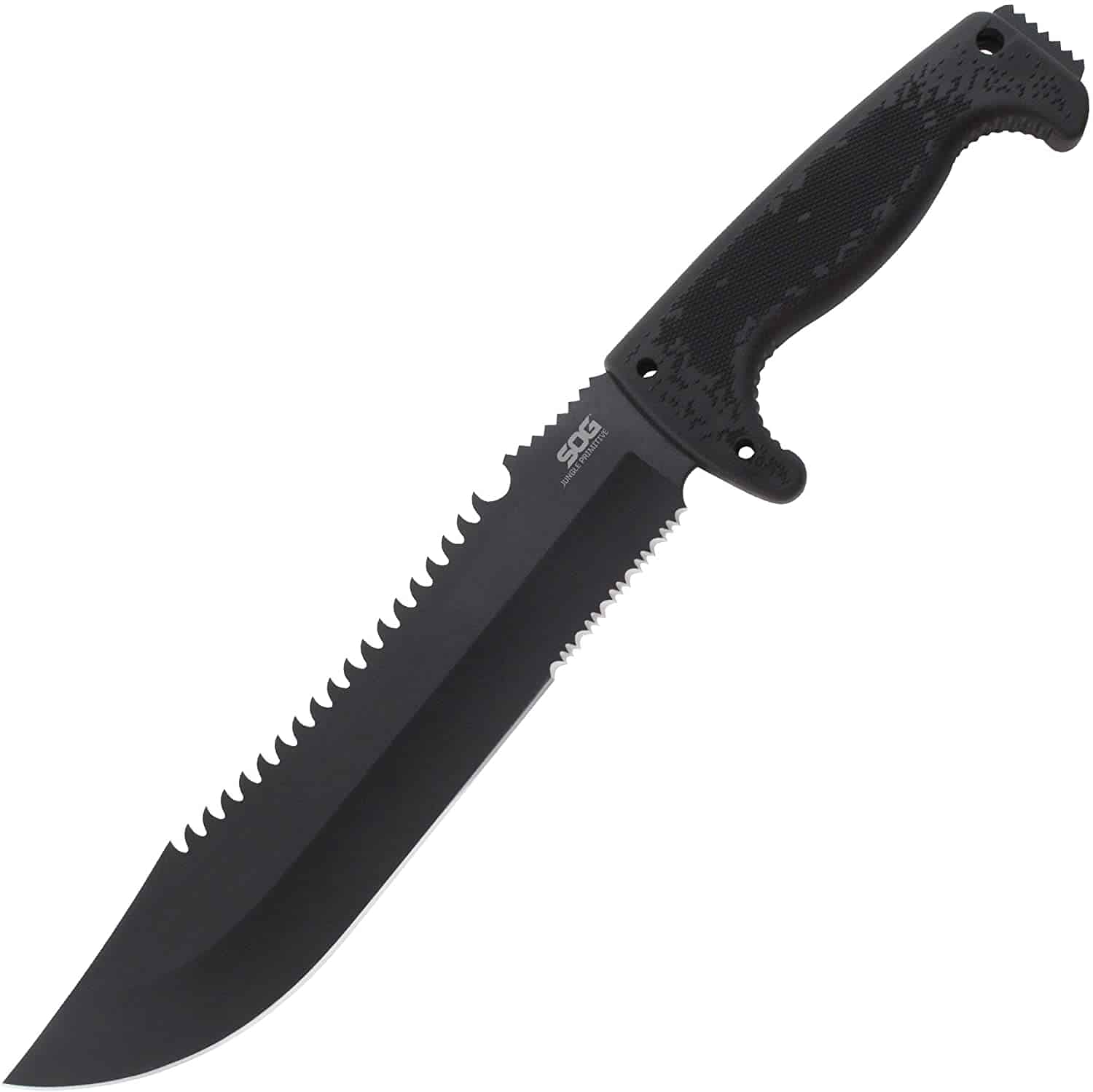
This Kukri/Machete hybrid from SOG features a saw back instead of the conventional straight back.
The result is a very utilitarian design that can clear undergrowth fast if used as a machete, as well as cut through thicker tree limbs without the need to baton the spine.
The 9.5-inch 8Cr13MoV-stainless steel blade has the weight centered towards the recurve which makes it easier to handle.
It has a comfortable Kraton rubber handle with an ergonomic design that makes it easy to grip without palm fatigue.
And despite being a whopping 15.3” in length, it weighs less than a pound. Makes the perfect all-purpose camping knife.
All said and done, this isn’t a knife that can take a lot of abuse. The 8Cr13MoV-stainless steel blade isn’t thick as the blades on some of the other kukris in this list. So if you are going to use this as an everyday carry, it probably will get damaged a lot sooner than you expect it to.
But it’s a budget-priced machete. And at the price point, it is a reasonably good knife.
Just that you’ve got to have realistic expectations from it.
The tactical, black matte finish also makes it a great show piece or collectible.
Pros
- 3” Kukri with a saw back
- Weight centered towards the recurved belly
- Perfect for use as a machete and a compact saw
- Can hack undergrowth, cut through thin branches
- Comfortable rubber handle
- Comes with a nylon sheath
- Weighs less than a pound
Cons
- The 8Cr13MoV-stainless steel blade is prone to dings and damage
- Length can be difficult to manage
How to Select the Best Kukri
If this is the first time you are venturing out to shop for Kukris, then the many variations of the iconic knife that have invaded the market might be enough to make your head spin.
Here’s a brief buying guide that shows you the most important aspects to consider before you buy the best kukri.
An Authentic Imported Kukri vs. an American-Made Hybrid
New buyers are often torn between buying an authentic, Nepalese Kukri handmade by ‘Biswakarmas’ and a hybrid by an American brand.
As tempting as it might seem to buy an authentic Nepalese knife, they aren’t really versatile knives.
They are very effective at clearing undergrowth, for chopping and for use in combat. But if you are looking for one knife that can replace your machete, axe and skinning knife, then the Nepalese kukri isn’t it.
That’s the reason why American manufacturers have created hybrid knives that take the design of the kukri and rebalance it to make it more machete-like. It increases the functionality of the knife without compromising too much on the design.
Having said that, if you are looking for an iconic, wall-hanging conversation piece, then go for an imported Nepalese one by all means.
Blade length, Thickness and Balance
Kukris are available in a range of sizes, starting from 8” blades to 12” ones.
Pick a blade length depending on your intended use. For general use around camp, a 10” to 12” blade works fine.
Please bear in mind that the exaggerated recurve on the belly makes these knives a lot bigger than other types of knives. Like a machete of the same size.
If you hate carrying a bulky knife on your waist strap or are just looking for a collectible, then you might want to pick something smaller.
The thickness of the blade will determine the chopping power and the extent of flex it has. A thicker blade with a thicker spine will make short work of most chopping tasks. It can be used with a baton as well.
The caveat is that thicker blades will be heavy and more difficult to carry.
Thinner blades lack the chopping power that you need for heavy everyday use. These have more flex but are likelier to form dings or get damaged if you baton the spine.
When it comes to using the Kukri, the balance of the knife is as crucial as the technique.
Traditionally, Kukris have the weight centered towards the belly which gives it unparalleled chopping power. But mass produced newer knives may have the weight towards the tip which makes it difficult to wield.
Handle and Sheath
The handle can either be made of locally sourced wood or it can be water buffalo horn (Nepalese kukris only), or a composite material like Kraton Rubber.
It boils down to personal preferences over anything else.
Buffalo horn handles are prone to damage if you live in a hot and humid area.
Wood is more aesthetic than any other material. But composites offer a very affordable middle ground.
They can sustain the wear and tear of everyday use. And they are comfortable in all weather conditions.
A lot of buyers get hung up over the sheath that’s supplied with the knife. Personally, we don’t accord much importance to it.
Nepalese Kukris usually come with a buffalo hide sheath while American brands ship with nylon ones.
If you are a connoisseur and are looking to get the most out of your knife, you’d replace that stock sheath with a custom Kydex one anyway.
Closing thoughts
That sums up our list of the best Kukris in 2022.
Our #1 pick is the Taiwanese-made KA-BAR 2-1249-9 Kukri. It is a machete hybrid, is lightweight and versatile enough to be used for a variety of tasks around camp.
We have also picked two Nepalese imports by EGKH, who are one of the only legitimate brands that imports handmade Kukris from Nepal.
The Cold Steel model is a budget-priced pick. Just like the Sogfari Kukri with the saw-backed spine.
We hope that you are able to narrow down on the best kukri for your intended use from this list.

